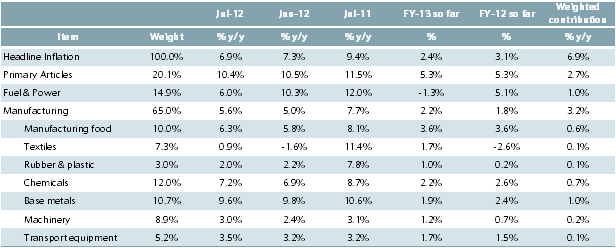India's wholesale price index (WPI) based inflation, at 6.87% y/y for July, sprang a major surprise as it turned out to be markedly softer than expectations (Barclays: 7.1%, consensus: 7.2%). This is the first sub-7% inflation print since November 2009. While the headline print appears to be a truly encouraging softening in inflation and gels well with our non-consensus view of sizeable RBI easing in the remaining months of FY 12-13 (100bps of repo rate cut), today's release raises a few concerns/doubts:
- Core inflation, which had broadly settled ~5% y/y in the previous four months, has gone up to ~5.4% y/y in July.
In a way, even though the sub-7% headline inflation print for July 2012 remained markedly lower than expectations (even softer than the lower band of the Bloomberg economist poll), one needs to be careful about trends in the same in subsequent months. Figures 2 below clearly indicate that the softness in current inflation print comes from lower weighted contribution from the fuel group and stable contribution from food products, a trend about which one cannot be certain in the coming months. Contribution from manufacturing inflation has, in fact, inched up in July 2012.
Trends in the WPI have been considerably more credible compared with some of the other government compilations in the recent past. We shall, however, remain watchful whether eventually the current print undergoes a somewhat bigger revision. While the current number caused an initial positive spark, we feel it will eventually face closer scrutiny from market participants.
Figure 1: Inflation and major components

Source: GoI, Barclays Research
Figure 2: Fuel group contribution softer
Source: GoI, Barclays Research
Figure 3: Core inflation up slightly
Source: GoI, Barclays Research
Figure 4: Food inflation somewhat softer
Source: GoI, Barclays Research
Figure 5: No revision in May 2012 provisional data
Source: GoI, Barclays Research
No change in our RBI policy view - we expect another 100bp repo rate cut in FY 12-13
Market expectations for monetary policy have demonstrated frequent and large swings in recent months. Inflation management has of late been the RBI's focus and the central bank remains cautious about delivering the next bout of rate cut just yet. Another hawkish set of comments came from the Reserve Bank of India's (RBI) governor yesterday, which continues to highlight inflation concerns. Today's inflation print will perhaps overshadow the same at least for a while.
There is no change in our monetary policy expectation owing to the current inflation print. We feel that markedly sub-par growth, a softening in core inflationary pressures over the next six months, near-zero fiscal spending headroom, and likely only hesitant government policy initiatives to revive the economy will eventually lead to greater monetary accommodation in the coming months, in our view. We maintain our expectation of another 100bp of repo rate cuts in FY 12-13. The timing of such cuts will depend critically on the trajectory of headline inflation in the next 3-4 months, which will, in turn, depend quite a lot on food inflation. Given the RBI's repeated inflation-fighting rhetoric, delays in further cuts to the RBI's headline policy rate cannot be ruled out. However, in that eventuality, rate cuts could be sharper in the latter half of the year.
Interestingly, media statements from the new finance minister hint at his preference for softer near-term interest rates. We need to be mindful of whether or nor not such an inclination by the Ministry of Finance (MoF) would have any meaningful influence on the central bank's policy decisions in the coming months.
We recommend staying long government bonds
The weaker-than-expected inflation print will likely re-ignite market expectations of a rate cut, especially as this follows the weaker-than-expected inflation print. We continue to recommend staying long G-secs given expected policy support as well as demand from banks given low credit growth. We had earlier recommended going long bonds (entry 8.10%, stop 8.40%, current 8.11%) targeting a move towards 7.50% by end October (see India: Position for a possible shift in liquidity - receive rates, buy bonds, 15 June 2012). While the absence of a repo rate cut last month poses an upside risk to our yield targets, we think that G-secs are still a good investment in India. As we had anticipated, the SLR cut did not reduce the demand for bonds from banks, given the low demand for credit. The current growth dynamics likely mean that credit growth is unlikely to pick up meaningfully unless lending rates are lowered, which we think is necessary though not sufficient for an improvement in credit demand. Separately, we continue to expect the RBI to buy ~INR1.25trn of bonds this fiscal year and with the markets likely taking the new Finance Ministers' comments on fiscal consolidation positively, we think that policy support for bonds will likely continue in the medium term. While we acknowledge that we might have to take near-term mark-to-market losses given the heavy supply calendar in August, we remain comfortable with the view that bond yields are unlikely to drift materially higher from current levels. Hence, we maintain our recommendation of staying long bonds even if our target levels may currently appear optimistic.
(Siddhartha Sanyal is Director and Chief India Economist with Barclays Capital.)







